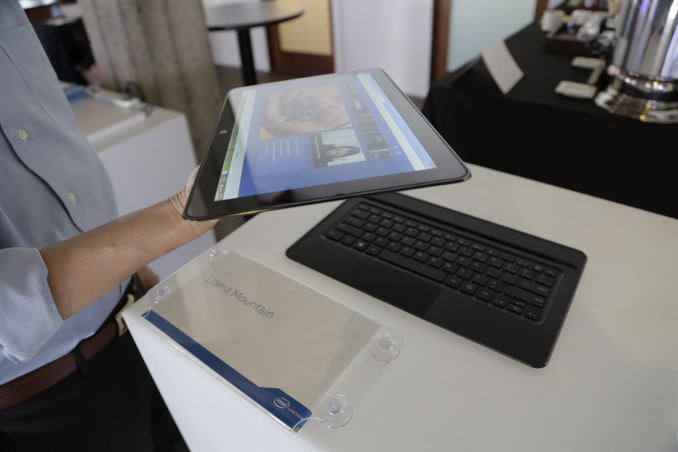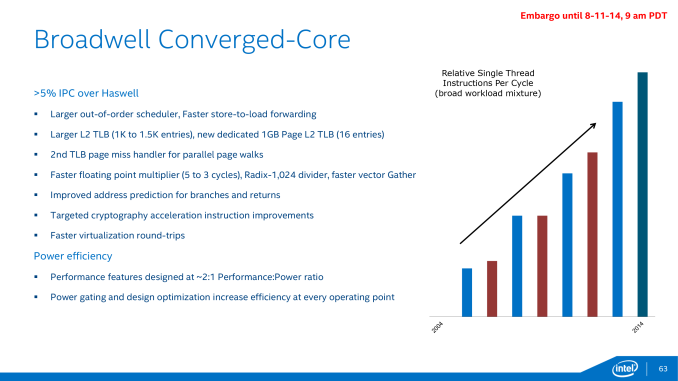Intel Broadwell Architecture Preview: A Glimpse into Core M
by Ryan Smith on August 11, 2014 12:01 PM ESTClosing Thoughts
Wrapping up our preview of the Broadwell architecture and Intel’s Core M processor, the bulk of Intel’s presentation and focus today is on the latter, so that is where we’ll start.
Core M is not a make-or-break product for Intel, but none the less it is a very important one. Mobile devices – be it tablets, slates, transformers, 2-in-1s etc – are continuing to increase in popularity, and as we’ve seen with ARM based tablets so far they form a market that has continued to grow and continued to erode the x86 laptop market that Intel has dominated for so long. Though laptops as a category are not going anywhere any time soon, their erosion means that Intel needs to get into mobile devices if they want to maintain their sales and their stature. To that end it’s not too late for Intel to break into this market and turn things around, but if they’re going to succeed then they need to make their move sooner or later, and this is where Core M fits in.
It’s telling then that while Intel is going after this market with a Core architecture, they are doing so under a different Core brand. Core M doesn’t just represent a new low powered Core CPU, but in Intel’s eyes is another product entirely. One that is so different that it does away with the Core i3/i5/i7 convention entirely and gets its own brand name and own product numbers. Core M is still Core, but it is nearly unrecognizable compared to the Core of even 4 years ago.
As far as the Core M product is concerned then, while Intel’s plans are grand they are not without merit. Backed by Intel’s new 14nm process and the Broadwell architecture, Core M looks like it should finally resolve the issues that dogged even Haswell-Y by bringing down power consumption even further while improving on Intel’s already strong performance, and getting the resulting processor in an SoC small enough to be usable in even the thinnest mobile devices. In fact from a technical perspective there’s little reason to doubt Core M; we’ll still have to wait to see just how good the resulting retail products are, but there shouldn’t be any technical reason for why it can’t be put into a mobile device comparable to today’s 10”+ tablets. Intel’s own Llama Mountain reference design can vouch for that much, showcasing the viability of Core M in a 12.5” tablet that’s just 7.2mm thick.
Intel's Llama Mountain, a Core M form factor reference design
More likely what will determine Core M’s fate and Intel’s ability to completely break into the mobile device market will be pricing. Intel’s profit margins are somewhat legendary in the computer industry, and a big part of that profitability has come from the high prices Intel has enjoyed from products such as their Core processors. Core M, like the other Cores before it, will still be an upscale product – a higher priced, higher performance alternative to Intel’s mass-market Atom processors. And while that makes plenty of sense on paper, in the real world Intel has to face the AllWinners and other ARM vendors of the world who are happy to sell their ARM SoCs at significantly lower margins, which can have a knock-on effect even if they can’t compete with Intel on overall performance. At this point it’s far too early to call this, especially when Intel isn’t even discussing Core M pricing at this time, but it’s a subject that Intel will have to consider carefully as “good enough” ARM devices will continue to be the biggest threat to Intel’s position in the CPU market.
Moving on, while today’s release from Intel only offers us a preview of what Intel will be delivering with their Broadwell architecture, what Intel has presented thus far looks to continue Intel’s tradition of relentless execution. As a tick Broadwell is a small but respectable improvement in Intel’s Core architecture, with the expected 5% IPC improvement in-line with previous ticks. For more traditional desktops and laptops it won’t radically change the world, but then it never was meant to. The biggest question for these parts will be whether Broadwell will improve on Haswell’s clockspeeds at all – a clockspeed boost made possible by Intel’s 14nm process – or if we’re going to hold steady similar to what we saw with the last tick, Ivy Bridge.
Meanwhile Broadwell’s GPU improvements are more significant, and in the race to further improve what’s essentially the baseline for PC GPU performance it is always welcome. Furthermore the fact that Intel is now at API feature parity with discrete GPUs is a big deal for Intel and it is a big deal for iGPUs as a whole. What we still want to see is more performance; a single slice seems just about right for Core M, but if we’re talking about larger laptop and desktop parts it would be very nice to see something akin to GT3 become baseline, especially with the die size savings Intel will be seeing from the 14nm process.
Finally, from here the rest of Intel’s 2014 should be rather busy. Next month is Intel’s Fall IDF 2014, at which point we expect we’ll be given a deeper look at Broadwell’s architecture. Past that the first Broadwell-Y based Core M processors will be on the shelves for the holidays, and with it our chance to see Broadwell and Intel’s 14nm process in action. However that will also be our only chance to see Broadwell in action this year; while Core M will ship in time for the holidays, the rest of the Broadwell lineup will not appear until 2015.













158 Comments
View All Comments
Morawka - Monday, August 11, 2014 - link
wasn't gartner the one who said apple mac sales were down 40% and it turned out to be up 60%mkozakewich - Thursday, August 14, 2014 - link
Those weren't actual numbers, they were industry guesses. The lesson is not to trust pundits and "Industry analysts". If you can wait for proper news to be released, it's better than rumours.lilmoe - Monday, August 11, 2014 - link
Actually, the tablet market as a cause for dropping PC sales is only half or less than half of the story. Logically speaking, most consumers find their 2-4 year old machines sufficient for their "productive" needs. Unlike previous years, PCs are living far beyond their intended years of services, and consumers are in no dire need for newer, faster components. Mind you, hardware isn't getting that much faster with each iteration (relatively speaking), and a simple SSD upgrade and/or more RAM would improve performance significantly that a whole hardware upgrade becomes less appealing (same for other components). It's mostly about convenience, connectivity and mobility for consumers these days (cheap mobile media consumption) that's why the tablet market "appear" to have affected PC sales. Those who find a tablet replacing their fully fledged PC didn't need a PC in the first place.mayankleoboy1 - Monday, August 11, 2014 - link
i remember being very excited to read the Haswell architecture preview.Felt completely disappointed when the actual CPU were reviewed.
Hope BDW-Y is not the same
edlee - Monday, August 11, 2014 - link
they should make a chromebook with this processor.Krysto - Monday, August 11, 2014 - link
My guess is this chip won't be that much faster than Nvidia's Denver - unless Intel cheats in benchmarks somehow (like with TurboBoost).68k - Monday, August 11, 2014 - link
How on earth is TurboBoost cheating? Is it cheating to include a feature that actually does result in a CPU that allow itself to do short sprints in moments where it is needed the most in order to make a device "feel" fast (i.e. respond quickly to events generated by the user)?Cannot talk for BDW but both HSW and SMT usually stay at or very close to max turbo for _very_ long, Z3770 sitting inside a 10" tablet can run at 2.3-2.4GHz on all 4 cores for several minutes.
nonoverclock - Monday, August 11, 2014 - link
AMD has a turbo mode. Do they cheat?psyq321 - Tuesday, August 12, 2014 - link
TurboBoost is not cheating but optimal demand-based power management.All modern ARM CPUs are also doing the same thing (scaling down frequency when idle, up when busy). I am quite sure it is the case with the AMD CPUs, too - it is just that I do not have any to check.
The only three things that matter are a) price b) performance c) power draw (real that is measured, not marketing terms such as TDP, SDP, etc.).
mkozakewich - Thursday, August 14, 2014 - link
TDP isn't a marketing term, it's the wattage of heat displayed by the processor. Wattage is a bit of a weird word for it, but Watts are joules-per-second, and a joule is the amount of energy needed to heat water a certain amount.